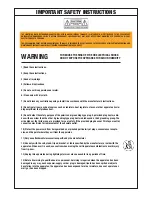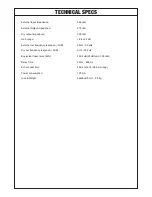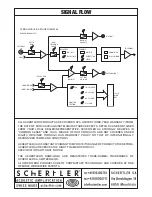
ART48 - SPRING
Driver section
The spring unit includes three output and input amps.
Please note that all three phone connectors are intended for sending
balanced signals, using space-saving stereo phone plugs. The tip connects
as usual to the hot signal (+), the ring to the cold (-) and the sleeve to the
ground.
One advantage of using phone plugs is that you can also connect an
unbalanced music signal, via a mono jack, to any of the outputs.
The spring unit receives and sums the AUX 1 from the bus.
Setting the AUX 1 knob on each individual input channel (mic In, yellow
instrument in, or stereo in) lets you send the desired amount of signal to the
spring unit.
The “AUX1 to spring” level fader(1.) lets you control the amount of signal
being sent to the spring reverbs. The two “nominal and peak” LED VU (2.)
controls will help you determine the best position for this fader.
However, driving the actual springs is also a matter of taste:
Keeping the signal down on the send level fader creates a smoother
reverberation effect with slightly longer delay. Pushing the signal on the
send level fader makes the reverberation sound richer and shorter, but also
slightly more metallic.
Activating the delay section - by depressing the Delay On(3.) switch (green
light) - lets you add a retard or delay before the signal is sent to the springs.
This effect imitates the room acoustic of a concert hall or church, where an
instant may pass before you can hear the reflections from the ceiling and
walls (100 ms for example). The knob labeled 20ms/200ms(4.) reacts on the
delay time, which is adjustable from 20 ms to 200 ms.
The echo puts a soft echo on the springs, imitating a room acoustic with
added echo effect such as a big bathroom, a car park with a long echo, or a
concert hall with a short echo.
Activate this section using the Echo On(5.) switch (green light). Use the
Slow/Fast knob(6.) to set the speed of the echo repetitions and the Short/
Long knob(7.) to set the length of the echo before it fades away.
As its name implies, the Short/Long(8.) time knob makes the reverberation
time longer as it is turned from left to right i.e. short to long. Aside from
determining the amount of reverberated signal applied to the original, it also
forms an important “artistic” parameter: In a ballad or spacey piece of music,
a long decay will fit well, giving depth to the overall sound. However, in a fast
piece, a short decay will keep the result drier and less “confused”.
The reverb mode section lets you choose between four different spring
characteristics. These will either result in richer or more transparent
reflections (ROOM - HALL)(9.), or in warmer or harsher ones (WOOD -
GLASS)(10.). Note: This section does not apply the usual equalizer on the
reverb’s output, but instead consists of four selectable drivers, which drive
the springs in different ways.
1.
2.
3.
4.
5.
6.
7.
8.
9.
10.


























